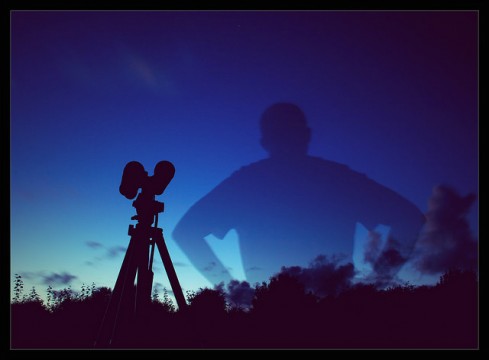Amateur astronomer Tom Price-Nicholson shares his list of astronomy targets for small binoculars.

I'm interested in stargazing, but prefer to use binoculars for astronomy instead of a telescope. Binoculars are cheaper and easier to maintain, and they require minimal set-up time — just grab and go.
One thing that always frustrated me, though, was my lack of a quick-reference list for targets within reach of small binos. I'd often find an astronomical object to look at in one of my deep-sky atlases, go outside to find it, and discover it was too dim to see in handheld binoculars.
Building the Binocular Stargazing Catalog
I imagined other binocular astronomers might have the same problem. With that in mind, I've compiled a list of 150 deep-sky objects that can be seen using a pair of 7×50 binoculars, ordered by magnitude. I had only one criterion when compiling the list: the object had to be visible in these smaller handhelds. I started by looking at the Messier catalog (always a favorite starting point), as well as Sir Patrick Moore's Caldwell catalog. I put together a database of deep-sky objects drawn from these two sources, including the easy-to-find Pleiades and Andromeda Galaxy, as well as a number of open clusters. As I went along, I noticed a few other objects that could be added, like the Large Magellanic Cloud.
To finalize my object list, I simply filtered out the objects I considered too dim to see. My first run through left me with 161 objects. I then filtered out even dimmer objects and was left with a nice, neat list of 150 objects. I haven't had a chance to find every one of them yet (that's British weather for you), but the ones that I’ve seen are brilliant. My favorite one is the Hyades Open Cluster: viewing it through binoculars, I can see hundreds of stars.
At the time I compiled this list, it was intended to be a reference document for me, so that I’d know quickly if I could find a particular object. After a while, I realized that other astronomers may be having similar problems, so I decided to get the list out into the public. Just click the link to download a copy of my Binocular Stargazing Catalog.
Clear skies and happy hunting!
 5
5
Comments
Psalm 19_1
April 19, 2016 at 2:09 pm
Thanks for this.
I live in southern California and have clear skies most every nite so I look forward to searching for and locating these objects.
By the way I use a set of 25x70 binoculars on a Ravelli APGL4 70" tripod w/adjustable pistol grip head.
Thanks again and Clear Skies!
You must be logged in to post a comment.
Bob
April 19, 2016 at 4:53 pm
Tom...
The Binocular Stargazing Catalog you compiled above is a good catalog for those who enjoy observing with two eyes.
On many dark nights I measure the skies in my backyard with the Quality Sky Meter (QSM, original model). The current model--many revisions later, I am sure--is available from Unihedron at this website: http://www.unihedron.com/projects/darksky/ I am not affiliated with Unihedron in any way.
A QSM measurement is often called an observer's Naked Eye Limiting Magnitude (NELM). On the best of nights I observe under 5.5 (NELM) skies--and I get to enjoy 5.5 skies about one or two dark moonless nights per year--very late in the evening after my neighbors go to sleep. For me, most nights produce a lower NELM--say 4.0 or 5.0. Some observers report they measure their skies at 6.5, 7.0, and better.
Many factors interact together to deliver a specific apparent magnitude (ML or vmag) to the pupils in my eyes. Unlimited articles and formulas have been posted on binocular-related astronomy Internet sites--and understanding and agreement is hard to find. Most authors just post a few numbers, formulas, acronyms, and leave it at that.
All this to say--in my Kentucky backyard, I am quite happy if I see night sky targets of 8.0 ML with my 7x50 binoculars. Sometimes I see 8.4 ML stars and objects--but most nights I see a mag lower--7.5 ML.
Sorry for the rambling.
Thank you for the Binocular Stargazing Catalog. I plan to use it a lot in the nights ahead.
...Bob
You must be logged in to post a comment.
Bob
April 19, 2016 at 4:59 pm
Opps ...
I should have entered the following:
Sometimes I see 8.4 ML stars and objects–but most nights I see 7.5 ML.
...Bob
You must be logged in to post a comment.
Anthony Barreiro
April 20, 2016 at 2:27 pm
Thanks, this is very useful! I have a few telescopes, but I do a lot more observing through binoculars. I often walk up to the top of a nearby hill (to get above the streetlights) with a pair of 11x56 porros and a sturdy camera tripod. Passersby are often surprised by how much you can see through binoculars, even in a badly light-polluted city. Even a pair of 8x42 binoculars shows a lot when I step out into the back yard.
You must be logged in to post a comment.
Ajoten
July 27, 2021 at 6:57 am
This is excellent, looking forward to ticking them off! Out of interest, how can one object have several NGC numbers?
You must be logged in to post a comment.
You must be logged in to post a comment.